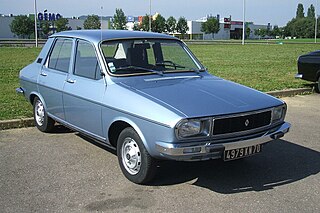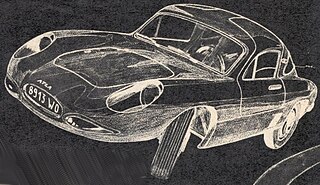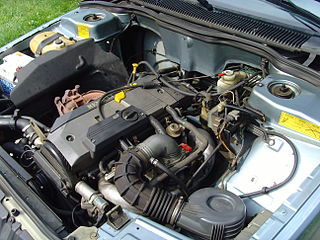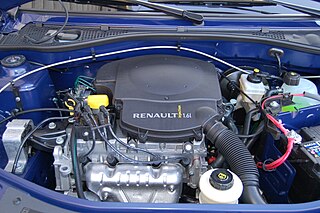
The Renault 12 is a mid-size family car introduced by French automaker Renault at the Paris Motor Show in October 1969 and produced in France until 1980. Available as a saloon (Berline) and estate (Break), it was also produced under licence in many countries around the globe into the early 21st century.

The Atla is a French automobile that was manufactured from 1957 to 1959 in the commune of Garches in the western suburbs of Paris.
The Ford CHT engine is an inline four-cylinder internal combustion engine produced by the Ford Motor Company in Brazil during the 1980s and 1990s. It is unrelated to the similarly-named CVH engine.

The Ferrari Colombo Engine was a petrol fueled, water cooled, carburetted 60° V12 engine designed by Gioacchino Colombo and produced in numerous iterations by Italian automaker Ferrari between 1947 and 1988. The maker's first homegrown engine, its linear successor is the Lampredi V12, which it far outlived, the last Lampredi being made in 1959.

The Mitsubishi Saturn or 4G3 engine is series of overhead camshaft (OHC) straight-four internal combustion engines introduced by Mitsubishi Motors and saw first service in the 1969 Colt Galant. Displacement ranges from 1.2 to 1.8 L, although there was also a rare 2-litre (1,994 cc) inline-six version built from 1970 until 1976. The early versions have chain driven valvetrain while the later versions are belt driven and equipped with balance shafts.

The Chrysler Hemi engines, known by the trademark Hemi or maybe more commonly HEMI, are a series of American V8 gasoline engines built by Chrysler with overhead valve hemispherical combustion chambers. Three different types of Hemi engines have been built by Chrysler for automobiles: the first from 1951 to 1958, the second from 1964 to 1971, and the third beginning in 2003. Although Chrysler is most identified with the use of "Hemi" as a marketing term, many other auto manufacturers have incorporated similar designs. The engine block and cylinder heads were cast and manufactured at Indianapolis Foundry.

The Renault Caravelle is a sports car manufactured and marketed by Renault for model years 1958–1968 in a single generation — as a rear-engine, rear-drive open two/four-seater designed by Pietro Frua of Carrozzeria Ghia, using the floorpan and engine of the Renault Dauphine.

The PSA X engine is a family of internal combustion engines used in Citroën, Peugeot, Talbot and Renault automobiles. The X family was mainly used in superminis and the entry level models of midsize vehicles. It was designed and manufactured by the company "Française de Mécanique", a joint venture created by Peugeot and Renault in 1969, and built in Douvrin in northern France. It is commonly called the "Suitcase" engine, the "Douvrin" nickname being commonly used for the bigger 2.0-2.2 liter J-Type engine, which was also built in Douvrin.

The Douvrin family is an all-aluminum inline-four automobile engine designed in the early 1970s and produced from 1977 to 1996 by Compagnie Française de Mécanique, a joint-venture between PSA and Renault located in the town of Douvrin in northern France. This engine is designed by the engineer Jean-Jacques His. It was produced in the same factory as the PRV V6, which also is sometimes known outside France as the "Douvrin" V6. The Douvrin engine is also referred to as the ZDJ/ZEJ engine by Peugeot, and as the J-type engine by Renault.

The Cléon-Fonte engine, also known as the Sierra engine or under the code "C-engine" or "C-Type", is a family of four-cylinder, inline automobile engines manufactured continuously by Renault and its subsidiary Dacia from 1962 to 2004. For about three decades it was a mainstay in Renault's compact models, before being gradually replaced by the E-type engine from the late 1980s onward.

The Renault DiET engine also known as "D engine" or "D-Type" is a straight-4 automobile petrol engine from Renault designed to replace the existing Cléon-Fonte engine in the Renault Twingo.

F Renault engine is an automotive internal combustion engine, four-stroke, inline-four engine bored directly into the iron block, water cooled, with overhead camshaft driven by a timing belt, and with an aluminum cylinder head, developed and produced by Renault in the early '80s, making its appearance on the Renault 9 and 11. This engine is available in petrol and diesel versions, with 8 or 16 valves.

The Cléon-Alu engine, also known under the code "A engine" or "A-Type" is an automotive gasoline internal combustion engine, developed and produced by Renault in 1960. A four-stroke inline four-cylinder design with aluminium-alloy block and cylinder head, it was water cooled, with a five main bearing crankshaft and a side-mounted chain-driven camshaft operating eight overhead valves via pushrods and rockers. It made its debut appearance on the Renault 16.

The Renault Energy engine also known as "E engine" or "E-Type" is an automotive gasoline four-stroke inline four cylinder internal combustion engine, with a sleeved water cooled cast iron block, equipped with 5 crankshaft bearings, an overhead camshaft driven by a toothed timing belt and an aluminum cylinder head with 8 overhead valves. Developed and produced by Renault in the late 1980s, the engine made its first appearance in the Renault 19.

The K-Type is a family of inline-4 automobile engines developed and produced by Renault since 1995. This is an internal combustion engine, four-stroke, with 4 cylinders in line bored directly into the iron block, water cooled, with tree (s) driven overhead camshafts driven by a toothed timing belt and an aluminium cylinder head. This engine is available in petrol and diesel versions, with 8 or 16 valves.

The E0 series is a three-cylinder gasoline engine developed and manufactured by Honda, with a total displacement of 656 cc. The engine is intended for kei car applications. The E05A and E07A were partially replaced by the Honda P engine but as of 2020 the E07Z engine still saw use in the Acty truck.
Autobleu was a French automotive parts manufacturer based in Paris. They produced a variety of components, but were best known for their intake and exhaust manifolds. They also built a small number of customized cars based on models from larger manufacturers.

The Renault 8 is a rear-engined, rear-wheel drive small family car produced by the French manufacturer Renault in the 1960s and early 1970s. It also formed the basis for the larger Renault 10, introduced in 1965.
The Simca Type 342 and 345 Engines were four-cylinder OHV engines, produced from 1963 through 1975, and used in the Simca mid-size 1501/1301 chassis. It was developed and produced by Simca in the early 1960s to be used in the Simca 1500.
















